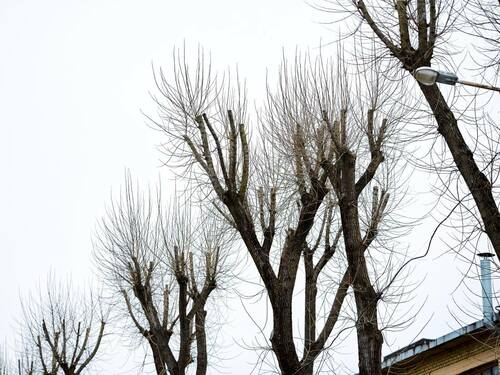Rescuing Topped Trees: A Comprehensive Guide to Tree Recovery
Introduction
Have you discovered a topped tree in your landscape ? While this situation can be challenging, there are effective steps you can take to help your tree recover and thrive. This guide will walk you through the process of fixing a topped tree and explain why proper tree care is crucial for your landscape’s health and beauty.
Understanding Topped Trees: What Are They?

A Tree Topped with Large Branches Cut Back
Before we dive into recovery methods, let’s clarify what a topped tree actually is.
Definition of Tree Topping
Tree topping is the practice of drastically reducing a tree’s height by cutting off the crown to a predetermined level. This process involves making heading cuts across the entire tree.
Key Point: A heading cut removes the terminal portion of a branch back to a lateral branch or bud. This can severely shock the tree, potentially killing it or causing erratic growth patterns.
Alternative Terms for Tree Topping
- Rounding over
- Hat-racking
- Heading
- Tipping
Expert Insight: “Tree topping is one of the most harmful pruning practices known. It often results in a stressed, weakened, and potentially hazardous tree,” says Dr. Linda Chalker-Scott, Extension Urban Horticulturist at Washington State University .
The Negative Effects of Tree Topping

A Row of Trees Showing the Effects of Topping
Understanding why topping is harmful can help emphasize the importance of proper tree care:
- Starvation: Removing leaves reduces the tree’s ability to produce food
- Shock: Sudden exposure to sun and elements can damage bark
- Decay: Large wounds from topping cuts are slow to heal and prone to decay
- Weak Regrowth: New growth is often weakly attached and prone to breaking
- Increased Maintenance: Topped trees require more frequent pruning
Step-by-Step Guide to Fixing a Topped Tree
Follow these steps to help your topped tree recover:
1. Practice Patience
Resist the urge to immediately prune your topped tree. Allow time for the tree to restore energy and develop new growth.
2. Monitor New Growth
Observe the multiple sprouts that will grow from the topping cuts. Leave these alone until they are well established.
3. Identify Dominant Branches
Look for the tallest, healthiest branches in the tree’s canopy. These “leader” branches will be crucial for the tree’s future structure.
4. Selective Pruning
Once new growth is established:
- Cut weak sprouts back to the trunk
- Leave stronger, shorter sprouts that could potentially keep up with the leader
- These retained sprouts will eventually become new limbs
5. Ongoing Care
Repeat this process over the next 4-6 years to guide the tree’s recovery and shape.
Pro Tip: Always use clean, sharp pruning tools to make clean cuts that heal more quickly.
Natural Healing Process for Topped Trees

A Topped Tree Showing Sparse Branch Growth After Improper Pruning
If you’re unable to actively manage the tree’s recovery, it’s important to know that topped trees can heal on their own to some extent.
Natural Recovery Timeline
- Year 1-2: Rapid growth of multiple sprouts
- Years 3-5: Some sprouts become dominant, others die back
- Years 5+: Tree begins to regain a more natural shape but may never fully recover its original form
Note: While natural healing is possible, the aesthetic result may not be as pleasing as with guided recovery.
When to Seek Professional Help
Some situations call for expert intervention:
- Large or mature trees
- Trees near structures or power lines
- Signs of disease or pest infestation
- Lack of time or tools for proper care
Benefits of Professional Arborist Services:
- Expertise in tree biology and proper pruning techniques
- Specialized equipment for safe and efficient work
- Knowledge of local regulations and best practices
- Ability to assess and address underlying health issues
For residents in the San Francisco Bay Area, Arborist Now offers comprehensive tree care services, including the restoration of topped trees. Our team of certified arborists can help guide your tree’s recovery and ensure its long-term health and beauty.
Preventing Future Tree Topping
To avoid the need for recovery in the future:
- Choose the right tree for the right location, considering mature size
- Practice proper pruning techniques from a young age
- Educate yourself and others about the dangers of topping
- Consult with a certified arborist for large pruning jobs
Conclusion: A Second Chance for Your Topped Tree
While tree topping is a harmful practice, it doesn’t have to be a death sentence for your tree. With patience, proper care, and potentially professional help , your topped tree can recover and continue to be a valuable part of your landscape.
Remember, healthy trees contribute to property value, air quality, and overall environmental health. By rescuing your topped tree, you’re not just improving your landscape—you’re contributing to a healthier ecosystem.
Ready to give your topped tree the care it needs? Contact Arborist Now today for expert guidance and services in tree recovery and maintenance!
Originally posted on March 4, 2020.


